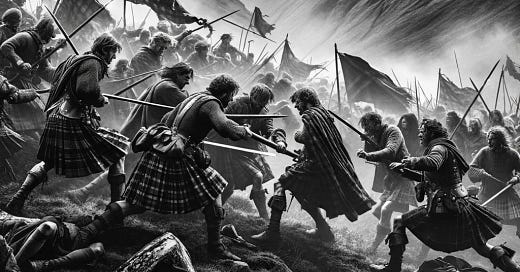In the annals of Scottish history, nestled among tales of battles and heroism, lies the poignant story of Gillespie's rebellion. This uprising, occurring in the early 13th century in the region of Moray, stands as a powerful testament to the enduring spirit of resistance and the complex tapestry of power and politics in the Highlands. This rebellion was not just a local skirmish but a pivotal event that would shape the future of this area and leave an indelible mark on the broader landscape of Scottish history.
The Spark of Rebellion
The origins of Gillespie's rebellion can be traced to the profound changes sweeping through Scotland following the Norman conquest and the introduction of feudalism. Moray, a region known for its vast territories, considerable autonomy, and a strong sense of identity, had long been a bastion of Gaelic tradition and a significant challenge to the centralized authority of the Scottish monarchy. The death of key figures like Donald Macmalcolm, the king of Scotland, and Maolsnectan Maclulaigh, the king of Moray, in 1085, marked a significant turning point, signaling the decline of the ancient Maormors of Moray and the rise of Norman influence.
As the 12th century gave way to the 13th, the Gaelic order in Moray found itself increasingly under threat. The once-powerful Maormors were being replaced by Norman earls, an imposition that was met with growing discontent among the people of Moray. Gillespie, a figure shrouded in mystery but brimming with ambition and charisma, emerged as a leader of this discontent. He became the rallying point for those yearning for the return of Gaelic rule and the old ways of the Highlands.
Gillespie's Uprising
Gillespie's rebellion was more than just a military campaign; it was a daring and audacious movement that sought to reclaim the lost glory and independence of Moray. His actions, characterized by a series of swift and violent offensives, were direct challenges to the Norman rule. Gillespie and his followers targeted symbols of Norman authority, attacking and burning wooden castles, and made significant strategic moves such as the surprise attack and killing of Thomas of Thirlstane, a baron close to Malcolm IV, and the burning of Inverness. These acts were not mere military tactics but powerful statements against the erosion of Gaelic culture and the imposition of a foreign feudal system.
The King's Response
The response from the Scottish monarchy to Gillespie's rebellion was both immediate and forceful. King Alexander II, recognizing the grave threat posed by Gillespie's actions, personally led the efforts to suppress the uprising. The initial campaigns by the king and his forces, however, only met with limited success, a testament to the depth of support Gillespie had managed to secure among the local clans and the populace of Moray.
It was only in the subsequent year, under the leadership of William Comyn, the Earl of Buchan and the Justiciar of Scotland, that the rebellion faced a decisive blow. Comyn's campaign was characterized by both strategic acumen and ruthless efficiency. The rebellion was quashed, and Gillespie, along with his sons, met a tragic and violent end. Their deaths marked a pivotal moment in the uprising, effectively ending any immediate organized resistance in the region.
Consequences and Legacy
The rebellion's aftermath brought about significant changes in Moray. The Scottish monarchy took drastic measures to prevent further insurrections, leading to widespread depopulation in large parts of Moray. The lands were redistributed to Norman families, altering not just the political but also the cultural and demographic landscape of the region. This marked a profound shift in the power dynamics of the Highlands, laying the groundwork for a more centralized and feudal system of governance.
The rebellion of Gillespie, though ultimately unsuccessful in its immediate objectives, left a lasting impact on Scottish history. It highlighted the resilience and fierce independence of the Highland clans and underscored the complexities and challenges of integrating Gaelic regions into a feudal Scotland. The uprising served as a poignant reminder of the continuous struggle for autonomy and cultural preservation, themes that would resonate throughout Scottish history for centuries.
In Gillespie's story, we find not only a narrative of resistance but also a crucial chapter in Scotland's journey through a period of significant transformation. It's a story that speaks to the enduring spirit of its people, their unwavering commitment to their heritage, and their resilience in the face of overwhelming change and adversity. The rebellion of Gillespie in Moray remains a powerful symbol of the struggles and triumphs that have shaped the Scottish identity.





